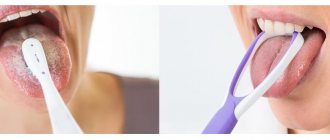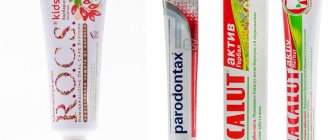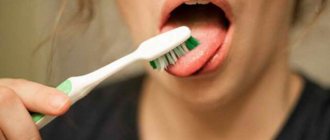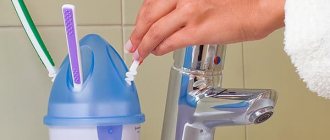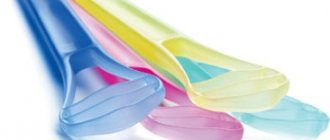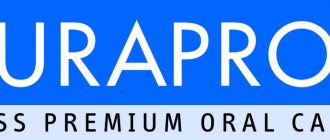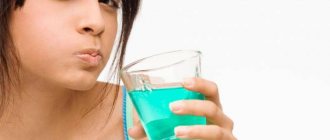For a beautiful smile and healthy teeth, it is necessary to perform high-quality oral cleansing
every day However, few people know that brushing your teeth is not enough and it is important to keep the surface of your tongue clean. Therefore, if questions arise about the benefits and harms of additional hygiene, then the answer is clear - it is needed.
With insufficient care, a coating forms on the tongue, which often signals the occurrence of serious pathologies and disruption of the human body.
Why does plaque form on the tongue?
Plaque on the tongue is formed due to the spread of pathogenic bacteria on the mucous membrane .
You should know! The reasons for the appearance of plaque are:
- Infectious diseases (HIV, tonsillitis, ARVI). In this case, the intensity of the plaque indicates a deterioration in the patient’s health. The more serious the problem, the denser the deposits on the tongue.
- Weakened immune system. Leads to the rapid proliferation of pathogenic bacteria and becomes the main cause of the formation of gray or white plaque. Most often, such plaque appears during illness and disappears after the patient recovers.
- Worms. They reduce human immunity and cause the proliferation of pathogenic microorganisms that can cause irreparable harm to human health. Parasites should be removed with the help of medications, since they will not disappear on their own.
- Poor hygiene and various dental diseases.
- Gastritis, ulcer. Accompanied by a thick layer of brown plaque with an unpleasant odor. To get rid of such plaque, you need to pay attention to nutrition. You need to avoid eating fast food and include more healthy foods, fresh fruits and vegetables in your daily diet.
- Taking antibiotics. After their cancellation, the plaque disappears within a few days.
- Oncological diseases. They have a critical effect on the general condition of the body and immune system. Plaque is not a symptom of cancer, but indicates complications.
- Candidiasis is a whitish or gray coating, reminiscent of grains of cottage cheese. After cleansing, the tongue may bleed, and without treatment, the plaque density will increase.
- Chlamydia. Leads to the appearance of sticky deposits not only on the surface of the tongue, but also on the teeth and gums.
- Respiratory diseases (pneumonia, bronchitis). A dense white coating that is easily removed, but then appears again.
- Smoking . Formations are yellow or gray. Over time they become denser and difficult to remove. When you give up the bad habit, the condition of the oral cavity will normalize and the plaque will gradually disappear.
Remember! The formation of plaque after eating is acceptable and is not a deviation from the norm. It can be easily removed with a toothbrush.
In addition, some foods and drinks may discolor the mouth an unnatural color, but this is not dangerous.
Why is this necessary?
With some problems with the gastrointestinal tract and diseases, the tongue becomes coated. Depending on the condition, it can be yellow, white or even black. In addition, pathogenic bacteria during their life processes can emit an extremely unpleasant odor, which repels others. To treat and prevent such conditions, it is necessary to regularly clean the tissues of the oral cavity. In addition, it is believed that by timely renewing the tissues of the tongue, you can begin to feel the taste of food more subtly and vividly. It’s hard to say whether this is true or not, but timely replacement of the epithelium and getting rid of the old one will definitely be beneficial.
In order to carry out the procedure correctly, you can even buy a special kit. Cleaning your tongue with it, if everything is selected and done correctly, will become easier and faster, and there will be a minimum of unpleasant sensations. Finally, regular implementation of the procedure will make the root less sensitive, which will result in a decrease or disappearance of the gag reflex. And one more plus - constant self-examination of the oral cavity will help you notice negative changes in a timely manner, for example the appearance of uncharacteristic plaque, ulcers, etc.
Reviews from people who have started regularly cleaning their tongue speak for themselves. Those surveyed note a longer feeling of freshness, worry less about bad breath, and get sick less often. Of course, some people find it difficult to overcome the gag reflex at first, but it goes away quickly. People quickly get used to the procedure and perform it daily, just like brushing their teeth.
Types of plaque and what diseases they signal
Keep in mind! Plaque on the tongue can be of several types:
- yellow – indicates diseases of the gallbladder or liver;
- white – diseases of the lymphatic system;
- gray – a sign of severe gastrointestinal damage;
- blue, green - indicates problems with the kidneys, liver, bladder or the appearance of fungus;
- black – serious pathologies.
The presence of plaque or its color should be determined before brushing your teeth in the morning and eating .
Characteristic signs of a “good” plaque
Normally, in a healthy person, food debris and waste products of microorganisms are washed off the tongue during meals. This is due to excessive salivation during meals.
But if you pay attention, you can see the remains of a light film. This does not always indicate health problems; in some cases, this is a normal phenomenon; the main thing is to understand how to distinguish a “good” plaque from a pathology.
You don’t have to worry about possible diseases if the following signs are identified:
- the coating is uniform, thin, light in color;
- the structure of the tongue (taste buds and papillae) is easily visible through the film;
- plaque appeared after eating;
- Easily removed with regular oral hygiene.
If there are no other symptoms, the plaque is probably formed for natural reasons inherent in every person - physiology.
Pathological plaque on the tongue can be determined by several reliable signs:
- specific unpleasant odor;
- a denser film through which the papillae of the tongue are not visible;
- color from yellowish to black;
- the film covers the entire tongue, and not just the root and basal part;
- cannot be removed.
There is a proven method for identifying bad plaque that you can use before running to a specialist. It is enough to brush your teeth and tongue, and then note the time. If the film appears earlier than 3 hours later, you should consult a specialist for advice on the functioning of the digestive system.
In addition, it is important to understand that the shade of plaque is influenced by the foods consumed. If the film has turned green, red or black, it is worth remembering what food you took at your last meal. Of course, if the problem is in dyes, there is no need to panic.
Dangers and Consequences
Keeping your tongue free of bacterial plaque helps maintain oral health.
Note! However, if you ignore this useful procedure, you may encounter the following consequences:
- diseases caused by fungi - in the form of white marks on the tongue;
- periodontitis – leads to tooth loss and gum inflammation;
- spotted tongue due to staining from drinks;
- unpleasant odor caused by bacteria located on the back of the tongue;
- impaired taste due to a large number of pathogenic bacteria and dead cells.
Beginner's Cleaner's Kit
Special devices for cleaning the tongue are the main assistants that help remove the plaque itself and the harmful bacteria accumulated in it.
The 3 most common, and most importantly, truly effective tongue cleaning devices come to the rescue: a special toothbrush, a scraper and a spoon. These devices do an excellent job of removing mucus and harmful bacteria from the mucous surface.
In each individual case, it is necessary to individually select one or another hygiene product, but there are also some general requirements:
- Toothbrush with reverse cleaning surface. Many people paid attention to the back of the toothbrush, made of rubber, but not everyone thought about its purpose. It often has a wavy coating with a rough surface. Such “washboards” are necessary for better hygiene. Also, specialized brushes are perfect for cleaning the front and back of the tongue.
- The scraper is a small plastic brush with a nozzle on the tip, made in the form of a spoon. At the end of the device there are special bristles, they are slightly smaller in size than those on a toothbrush. Some models may differ in the type of bristles. There is always the opportunity to purchase a soft or harder scraper.
- A spoon , like the tongue cleaners described above, is also a very effective help in ridding the mucous membrane of bacteria and plaque. Using a special spoon with a cleaning attachment, you can clean both the front and back of the tongue.
There are other devices for these purposes. But, unfortunately, they are not particularly effective and easy to use. If you need to clean your tongue, then pay attention to the specialized products listed above.
The initial kit may well look like this:
- Oral-B Pro-Expert is perhaps the best brush for cleaning teeth and tongue from bacterial particles. The manufacturer provides for active removal of plaque using the product for 3-5 months, after which the brush becomes unusable and requires replacement. Pro Expert is capable of removing up to 90% of plaque, and thanks to special bristles it will help remove bacterial deposits from the most inaccessible places.
- Tongue massager-cleaner “Freshness” . An excellent tool for daily care of mucous membranes and thorough removal of accumulated plaque from their surface. The scraper will help freshen breath, improve the sensitivity of taste buds and, thanks to thorough cleaning, prevent the occurrence and development of infectious diseases that appear due to abundant bacterial exposure.
- Spoon attachment for the Waterpik irrigator . The most popular model for cleaning the tongue and all thanks to its simple design, convenience, and, most importantly, efficiency when used in conjunction with an irrigator. A spoon will help you easily remove accumulations of bacteria without causing any discomfort or gagging.
What to clean with? Medicines and devices
To get rid of plaque on the tongue, it is important to maintain oral hygiene, especially at home .
When brushing your teeth, you should clean the palate, the inside of your cheeks, and pay special attention to the surface of your tongue .
How exactly can you carry out special hygiene? The following products and devices will help with high-quality cleansing
Toothpastes
Cleaning the tongue from plaque is carried out using toothpaste or a special gel with wound-healing properties.
Know! Among the best products, experts highlight “Splat” and “Aquafresh” pastes, which have an antibacterial effect and do not harm the health of the oral cavity and the body as a whole.
Gel "Mitrogil Denta" is suitable for people with high sensitivity and will effectively cleanse the tongue of various formations.
Using toothpaste to destroy unpleasant deposits does not require special skills and consists of several simple steps:
- Using circular movements without pressing, thoroughly clean the tongue.
- Move to the palate and inner cheeks.
- Rinse your mouth with a medicinal solution or plain water.
Toothbrushes
You can use either a regular toothbrush or a brush with silicone bristles on the back of the working head.
For effective cleaning, dentists recommend Colgate 360 and Oral-B Pro Expert toothbrushes , which do an excellent job of removing bacterial deposits.
Important! After finishing brushing your teeth, you should position the brush so that the rubberized pad touches the affected surface.
Move the brush several times along the tongue in one direction, and then rinse the mouth.
Special dental trays
A dental spoon consists of a nozzle and a spoon-shaped tip.
Most often, the device is used as a replacement attachment for an irrigator or electric brush.
also perform the tongue cleansing procedure after brushing your teeth.
To do this, you need to run the working surface of the nozzle along the tongue surface from the back to the tip.
Commercial gain and deception of people
Scientists from the University of Bergen in Norway analyzed all the latest publications in European medical journals related to the tongue cleaning procedure and drew their conclusions. Norwegian experts said that the need for regular tongue cleaning is purely a commercially induced habit. Millions of dental offices across the continent are simply making money off of a publicized but unfortunately non-existent need.
In terms of oral care, this is not even a useful feature, but a real mistake, since “...brushing can change or even damage the surface of the tongue and upset the balance of friendly bacteria, which also colonize the human digestive tract...” stated Norwegian scientists. However, all dental procedures in the world have been and remain among the most expensive and at the same time extremely in demand, therefore all innovations in this direction will certainly be promoted among the population of European countries.
Tongue scraper or tongue cleaner
A scraper for cleaning the affected surface consists of a handle and a flat attachment in the form of a triangular spoon . The attachments are offered in two versions: with and without bristles.
It is worth noting! Plastic scrapers and cleaners are more popular; they are convenient to use, but must be changed frequently.
Copper scrapers will last much longer, but products made from this material require special care.
How to properly clean your tongue?
Before using the scraper, you should brush your teeth and, if desired, use a mouthwash.
Then you can start cleaning the affected surface , following simple instructions:
- Open your mouth and stick out your tongue.
- Take the scraper by the handle and place the device on the back of the tongue. Do not overdo it so as not to trigger the gag reflex.
- Slowly move the scraper towards the tip. Repeat the movement a few more times to completely clean your tongue.
- Do not move the device in the opposite direction to prevent deposits from returning.
Know! The scraper should be rinsed with warm water until clean after each use on the tongue surface.
The best folk remedies
Thorough cleansing of the tongue from bacterial formation can be carried out not only with medical devices. Proven folk remedies that are easy to use at home will also help with this.
They
will quickly and effectively get rid of unpleasant deposits and also improve the health of the oral cavity.
Rose hip decoction with honey
Pour 50 grams of dried berries into two glasses of water. Bring the broth to a boil and cook for 10 minutes over low heat.
After cooling, add a teaspoon of honey. The product should be consumed on an empty stomach, half an hour before meals, 150 ml for three weeks.
Oak bark
Place 20 grams of oak bark and a glass of hot water into a small container. Bring the mixture to a boil over low heat. Allow the broth to cool to 40 degrees and strain.
Stay up to date! Use as a medicinal rinse three times a day after meals.
Propolis tincture
Add 10 drops of propolis alcohol tincture to 100 ml of water. Soak a cotton pad in the resulting solution and apply to the tongue for a few minutes.
Perform the procedure after brushing your teeth. The solution can be replaced with a piece of propolis, which should be chewed for 5 minutes.
Oil
Heat 5-10 ml of vegetable oil in a water bath to 37 degrees.
Add a couple drops of tea tree essential oil. Take the mixture into your mouth and move it in different directions for five minutes . Then spit out the product.
After the procedure, refrain from eating for 2 hours.
Medicinal herbs (calendula, chamomile, sage)
Place 10 grams of dry herb in a container and pour 1.5 cups of boiling water. Close the lid tightly and leave for four hours.
Strain and rinse your mouth 3 times a day after meals .
Soda
Reference! Dissolve one teaspoon of baking soda in 150 ml of warm water.
Rinse your mouth with the solution twice a day.
Barberry tea
Pour a tablespoon of dry barberry berries with a glass of boiling water.
Let the drink brew for 10-15 minutes. The daily intake of tea is 3 cups.
Essential oil
Add 5 drops of natural eucalyptus or rosemary essential oil to 100 ml of warm boiled water.
Rinse your mouth with the mixture 2 times a day. Essential oil cannot be applied in its pure form, as it can cause burns.
Components used in folk remedies treatment can cause a severe allergic reaction , causing burning and itching of the oral mucosa.
At the first symptoms of an allergy, you should stop self-medication and consult a doctor.
